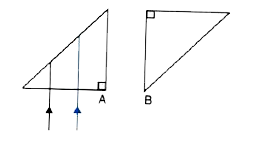Explain the following terms:
incident ray
Draw diagram/diagrams to show them.
Step-by-Step Solution:
1. Definition of Incident Ray:
An incident ray is defined as the ray of light that strikes a surface before being reflected or refracted. It is the incoming ray that approaches the boundary between two different media.
2. Understanding the Normal:
The normal is an imaginary line that is perpendicular (at a right angle) to the surface at the point where the incident ray strikes. It is essential for measuring angles related to reflection.
3. Angle of Incidence:
The angle of incidence is the angle formed between the incident ray and the normal. This angle is crucial in understanding how light behaves when it encounters a surface.
4. Diagram Representation:
To illustrate these concepts, we can draw a simple diagram:
- Draw a horizontal line to represent the reflective surface.
- At a point on this line, draw a vertical line to represent the normal.
- Draw an arrow approaching the surface to represent the incident ray.
- Label the angle between the incident ray and the normal as the angle of incidence (I).
Diagram:
||Normal||−−−−−−−−−−−−−−−−−−−−Ref≤ctiveSurface IncntRay
Summary of Terms:
- Incident Ray: The incoming ray of light that strikes a surface.
- Normal: The perpendicular line to the surface at the point of incidence.
- Angle of Incidence: The angle between the incident ray and the normal.
---
An incident ray is defined as the ray of light that strikes a surface before being reflected or refracted. It is the incoming ray that approaches the boundary between two different media.
The normal is an imaginary line that is perpendicular (at a right angle) to the surface at the point where the incident ray strikes. It is essential for measuring angles related to reflection.
The angle of incidence is the angle formed between the incident ray and the normal. This angle is crucial in understanding how light behaves when it encounters a surface.
To illustrate these concepts, we can draw a simple diagram:
- Draw a horizontal line to represent the reflective surface.
- At a point on this line, draw a vertical line to represent the normal.
- Draw an arrow approaching the surface to represent the incident ray.
- Label the angle between the incident ray and the normal as the angle of incidence (I).
||Normal||−−−−−−−−−−−−−−−−−−−−Ref≤ctiveSurface IncntRay
- Incident Ray: The incoming ray of light that strikes a surface.
- Normal: The perpendicular line to the surface at the point of incidence.
- Angle of Incidence: The angle between the incident ray and the normal.
Topper's Solved these Questions
- REFLECTION OF LIGHTBOOK - ICSECHAPTER - REFLECTION OF LIGHTEXERCISE - EXERCISE 7(B)
9 Videos
- REFLECTION OF LIGHTBOOK - ICSECHAPTER - REFLECTION OF LIGHTEXERCISE - EXERCISE 7(C)
54 Videos
- REFLECTION OF LIGHTBOOK - ICSECHAPTER - REFLECTION OF LIGHTEXERCISE - EXERCISE 7(C)
54 Videos
- PROPAGATION OF SOUND WAVES BOOK - ICSECHAPTER - PROPAGATION OF SOUND WAVES EXERCISE - EXERCISE -8(B) (Multiple choice type)
3 Videos
- SOUNDBOOK - ICSECHAPTER - SOUNDEXERCISE - TOPIC 2 Infrasonic and Ultrasonic Waves ( 3 Marks Questions)
3 Videos
Similar Questions
Explain the following terms:
reflected ray
Draw diagram/diagrams to show them.
View SolutionExplain the following terms:
plane mirror
Draw diagram/diagrams to show them.
View SolutionExplain the following terms:
angle of incidence and
Draw diagram/diagrams to show them.
View SolutionExplain the following terms :
Angle of reflection
Draw diagram/diagrams to show them.
View SolutionExplain the following terms:
angle of reflection.
Draw diagram/diagrams to show them.
View SolutionRefractive index of the material of concave lens is μ. The lens is immersed inb a medium of refractive index μ1(μ1>μ). A parallel beam of light is incident on the lens. Draw a diagram to show the path of emergent rays.
View SolutionThe following diagram explains

View SolutionA ray of light, after refracting through a concave lens, emerges parallel to the principal axis. Draw a ray diagram to show the incident ray and its corresponding emergent ray.
View Solution(a) Figure shows two isosceles right angled prisms A and B and the light rays incident on the prism A. complete the diagram to show the rays emerging out of the prism B.
(b) State the principle used for completing the ray diagram in part (a) above.

View SolutionDraw diagrams to show the formation of beats?
View Solution
